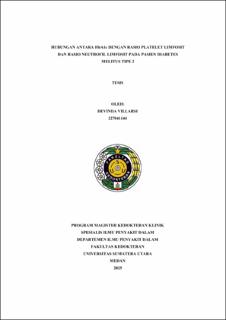Hubungan antara Hba1c dengan Rasio Platelet Limfosit dan Rasio Neutrofil Limfosit pada Pasien Diabetes Melitus Tipe 2
Relationship between Hba1c and Lymphocyte Platelet Ratio and Lymphocyte Neutrophil Ratio in Type 2 Diabetes Mellitus Patients

Date
2025Author
Villarsi, Devinda
Advisor(s)
Lindarto, Dharma
Pase, M. Aron
Metadata
Show full item recordAbstract
Background: Type 2 diabetes mellitus (T2DM) is a chronic metabolic disease in
which inflammation plays a significant role in both microvascular and
macrovascular complications. The Neutrophil-to-Lymphocyte Ratio (NLR) and
Platelet-to-Lymphocyte Ratio (PLR) are simple hematological biomarkers that can
reflect systemic inflammatory status and potentially correlate with HbA1c levels as
an indicator of glycemic control.
Objective: To determine the relationship between HbA1c levels and NLR and PLR
in T2DM patients at Haji Adam Malik General Hospital, Medan.
Methods: This was a retrospective cross-sectional study using secondary data from
the medical records of T2DM patients between May and July 2024. A total of 96
patients met the inclusion criteria. Data were analyzed using the Kruskal-Wallis test
with a significance level of p<0.05.
Results: The median HbA1c of the patients was 9% (range 4.2–15.4%). Median
NLR increased according to HbA1c categories: 3.91 (HbA1c <7%), 5.77 (HbA1c
7–9%), and 7.19 (HbA1c >9%) with p=0.012. Median PLR also increased across
categories: 134.75, 189.00, and 233.33 with p=0.009.
Conclusion: There was a significant relationship between HbA1c levels and both
NLR and PLR in T2DM patients. NLR and PLR can be used as additional
hematological parameters to assess inflammation and glycemic control in patients
with type 2 diabetes.
